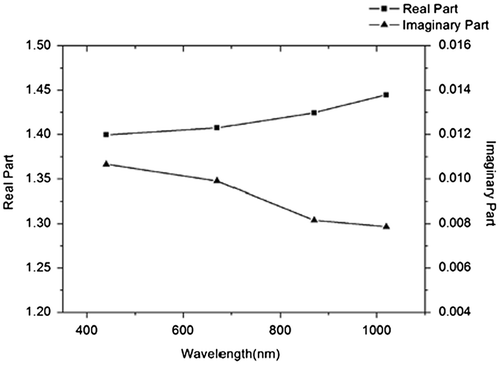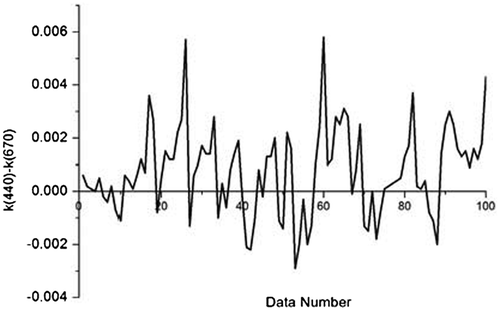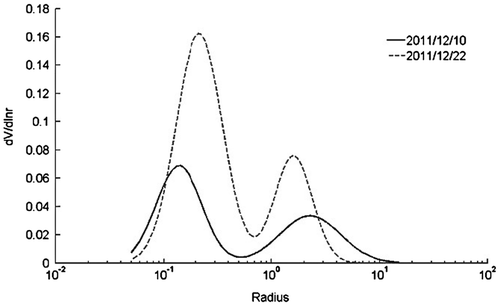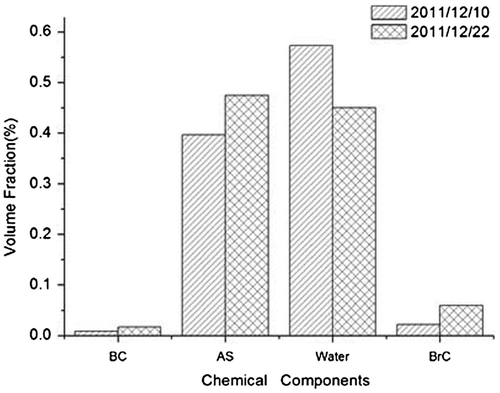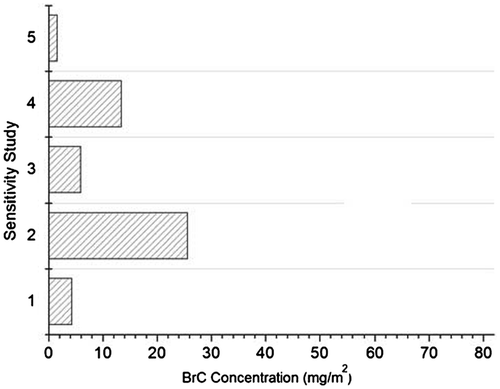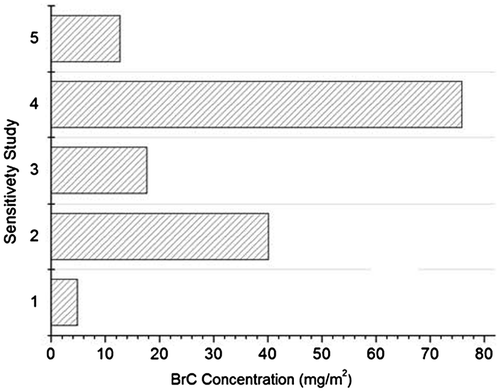Abstract
The impact of Brown Carbon (BrC) to aerosol light absorption has been paid more attention recently and there are a large number of studies showing that the influence of BrC on radiative forcing should not be ignored. BrC also acts as an important component of haze pollution which is occurring frequently in Wuhan, China. Therefore, it is essential to estimate their optical properties, composition, and mass concentration. Considering most haze pollution happens during the coldest time, we retrieved BrC columnar content during winter in Wuhan for the first time. Our method bases on the fact that BrC showed the strong spectral dependence on UV-light absorption. Using this method, we found that BrC makes up the small proportions of total aerosol volume (less than 10%). In the winter of 2011, we retrieved the daily-averaged columnar-integrated mass concentration of BrC on clear day is 4.353 mg/m2 while that of haze day is 12.750 mg/m2. According to the sensitivity study, we found that the results highly relied on the assumed aerosol refractive index. To reduce the uncertainty of this approach, we need to gain a better understanding of the temporal variability of the radiation absorbing components of these aerosols in the future.
1. Introduction
Aerosols play an important role in global climate through direct and indirect radiative forcing. Combustion-produced carbonaceous particles are the predominant radiation absorbing components of aerosols. Most direct radiative forcing models classify carbonaceous particles into two main types, strong radiation absorbing Black Carbon (BC) or negligibly radiation absorbing Brown Carbon (BrC). In 2001, Jacobson (Citation2001) pointed out that BC might warm the atmosphere and could become the second most important component of climate change after CO2. Ramanathan and Carmichael (Citation2008) published that the BC forcing of 0.9 W/m2 could lead to the temperature of 0.5–1.0 °C on a global scale. Later, Alexander indicated that a large amount of BrC existed in East Asian–Pacific outflow and suggested that BrC should be explicitly included in radiative forcing models (Alexander, Crozier, and Anderson Citation2008). Bahadur found that the BrC absorption at 440 nm was about 40% of that of BC and demonstrated that current climate models treating BrC as non-absorbing were underestimating the total warming effect of carbonaceous aerosols (Bahadur et al. Citation2012). Using a global chemical transport model and a radiative transfer model, Feng, Ramanathan, and Kotamarthi (Citation2013) estimated the enhanced absorption of solar radiation due to BrC in a global model, and global simulations suggested that strongly absorbing BrC contributed up to 0.25 W/m2 (19%) of all absorption by anthropogenic aerosols. BrC was also found to be ubiquitous and effectively absorb solar radiation based on observations over East Asia in spring 2001 (Sato et al. Citation2003). Obviously, the impact of BrC to the aerosol light absorption and its climatic implication cannot be ignored. Thus, it is essential to quantify the optical properties, composition, and mass concentration of BrC to determine accurately the magnitude of radiative forcing. Currently, the sources and formation of BrC and its temporal variability are not well understood. It is difficult to use the traditional thermos method to separate BC and BrC due to similarity of their chemical properties. Lately, the retrieval of BrC based on its optical properties obtained from remote sensing has been proposed.
In 2005, Schuster et al. (Citation2005) was the first to introduce an approach to determine the BC concentration from AERONET data based on the complex refractive indices of aerosol. Later, Dey et al. (Citation2006) applied the same approach, but also included BrC / dust as another absorbing component. Recently, Arola et al. (Citation2011) took advantage of the spectral-dependent properties of BrC to establish a BrC column-integrated concentration all over the world. Wang et al. (Citation2013) took dust into consideration when analyzing the mineral dust in Beijing.
2. Data and methods
2.1. Study area
Wuhan (30.5°N, 114.3°E), located in central China, is a typical industrialized city and has been the site of dramatic urbanization during the past decades. In winter, air convection is unlikely to occur due to the low temperature. The stable atmospheric structure leads to accumulation of pollutants, which means that the air pollution is frequent. The carbonaceous aerosols, including BC and BrC, are mainly generated from combustion process. Considering the emission sources and influential factors in Wuhan, BC here mainly comes from fuel consumption resulting from heavy traffic, while BrC is mostly generated from less efficient and incomplete combustion of coal, which is the major energy source for local industrial manufacturing.
2.2. Data and measurement
A CE318 sun–sky radiometer was installed on the roof of State Key Laboratory of Information Engineering in Surveying, Mapping and Remote Sensing (LISMARS) building (29.9°N, 113.9°E; 39 m high) at Wuhan University. The radiometer measures at eight wavelengths, centered at 340, 380, 440, 500, 670, 870, 940, and 1020 nm. Spectral AOD is obtained from direct sun measurements. Other aerosol optical properties, such as refractive indices, SSA, and the column-integrated aerosol size distributions are derived from sun and sky radiance measurements at 440, 675, 870, and 1020 nm by the inversion code proposed by Dubovik and King (Citation2000).
Aerosol complex refractive index is an important parameter for describing the capability of aerosols to scatter and absorb light. It is a complex number and the real part represents the capability for light scattering while the imaginary part represents the capability for light absorption.
In our study, we used the retrieved complex refractive indices at four wavelengths (440, 670, 870, and 1020 nm) during the winter of 2011. Figure shows the averaged aerosol complex refractive indices in this period. It is clear that the imaginary part has a strong wavelength dependence on UV band. Figure shows the differences between the imaginary part of 440 nm (k(440)) and that of 670 nm (k(670)). There are nearly 70% of all data whose k(440) is greater than k(670). The wavelength dependence of imaginary part of aerosol in the winter of Wuhan should be noticed.
The imaginary part indicates the ability to absorb light. BC, BrC, and mineral dust are three major light absorbing aerosols. On account of the climatic and geographical conditions of Wuhan, we do not take the influence of mineral dust into consideration. Kirchstetter, Novakov, and Hobbs (Citation2004) reported that Brown Carbon (BrC) showed the strong spectral dependence on UV light absorption, while BC exhibited the relatively weak wavelength dependence (Park et al. Citation2010). Similar absorption characteristics of BC and BrC have been reported after several other measurements (Bergstrom, Russell, and Hignett Citation2002; Andreae and Gelencsér Citation2006). Therefore, we find that the differences of k(440) and k(670) are caused by the strong light absorbing on UV band of BrC. In this way, we could retrieve the fraction of BrC using its unique optical property based on the aerosol complex refractive indices.
2.3. Methods
In order to focus on BrC, we simplified the aerosol to a mixture of BC, BrC, and ammonium sulfate (AS) embedded in a water host. We implemented this model to determine the volume fraction and column-integrated concentrations of BrC in the winter of Wuhan. We calculated an effective complex refractive index for aerosol using the volume averaged mixing rule. The assumed complex refractive index values of these components are given in Table . We used the values for the BC refractive index suggested by Bond and Bergstrom (Citation2006). We considered a spectrally independent imaginary part, () except BrC, for which we fixed
at 440 and 670 nm, with the values used by Kirchstetter, Novakov, and Hobbs (Citation2004). The real part at the four wavelengths
was assumed to be the same value for each aerosol component, considering that the small spectral dependence of
can be neglected in this study.
Table 1. Complex refractive index values of the components.
Given the refractive indices and volume fraction of the four aerosol components, the complex refractive indices of the aerosol mixture are calculated from the following equations:(1)
(2)
where i (=1, 2, 3, 4) denotes each aerosol component, fi denotes the volume fraction of the component i. Here, j (=1, 2, 3, 4) is the summation index over the four retrieval wavelengths (440, 670, 870, and 1020 nm).
The derived complex refractive indices of aerosol were computed for different combinations of volume fractions of four aerosol components by minimizing the following equation:(3)
where and
are the sun photometer-measured real refractive indices and imaginary refractive indices, respectively; the corresponding values for
and
are calculated from the model.
3. Results and discussion
3.1. Retrieval of BrC on two typical weather conditions
In order to exclude dust-dominated cases, we processed only those retrievals that had a ratio of fine mode to total volume concentration > 0.5. Moreover, we included a spectral imaginary index with the restriction that the imaginary index at 440 nm had to be larger than the mean of the imaginary indices at 670, 870, and 1020 nm. On the basics of these constraints, we have chosen two groups of data representing two typical weather conditions to describe the feasibility of the method. We selected 10 December 2011 with the clear weather while 22 December 2011 with the hazy weather. The aerosol optical depth in 550 nm (AOD(550)) is an important index which can indicate the weather condition. If the value of AOD(550) is larger, the weather condition is worse. The value of AOD(550) is approximately 0.376 on 10 December 2011, while it is 1.2071 on 22 December 2011. Figure shows the aerosol size distributions of these two days. It is obvious that the atmospheric aerosols in these two days are dominated by fine particles.
Figure shows the volume fraction of four chemical components under two typical weather conditions. The volume fractions of both BC and BrC were not very high, less than 10% of the mixed aerosol, and the volume fraction of BrC was much larger than that of BC. BrC tends to occupy the main volume fraction (3–10%) of radiation absorbing aerosols in the winter of 2011 in Wuhan. The volume fraction of BC was no more than 2% in all cases. We can also find that the volume fractions of BC and BrC on clear day are less than those on hazy day, which indicates BC and BrC are the main pollutants on hazy weather. BC and BrC are both generated from combustion. However, BrC is also generated by photochemical reactions of volatile organic compounds. Although the light absorbing ability of BrC is inferior to that of BC, the impact of BrC to radiative forcing should not be ignored considering the relatively large amounts of it.
According to the volume fraction of BrC, the column-integrated concentrations of BrC were then calculated using(4)
where fBrC are volume fractions of BrC that gave the best fit in Equation (Equation1(1) ),
is the particle volume distribution (available from the CE318 inversion product), ρBrCis the density of BrC, for which we used the value of 1.2 g/cm3.
In this way, we can calculate the daily-averaged columnar-integrated mass concentration of BrC ([BrC]) on clear day is 4.353 mg/ m2 while that on haze day is 12.750 mg/m2. Wang et al. (Citation2013) obtained monthly averaged values of [BrC] in the winter during 2009 to 2010 in Beijing, ranged from 70 to 90 mg/m2. Retrievals of BrC in Beijing varied from 30 to 35 mg/m2 during the coldest season (Arola et al. Citation2011). BrC emissions are mainly from coal burning. Beijing is located in northern China and its high [BrC] is possibly explained by the significant coal burning from winter heating. As for Wuhan, the city is at the confluence of the Yangtze River and Hanjiang River and has a typical subtropical monsoon climate. There is no need for large-scale coal burning for heating as in Beijing.
3.2. Sensitivity study
It should be noted that the assumed complex refractive indices of BrC are different in different studies. In order to carry out a sensitivity of our own approach, we estimated the BrC concentration using imaginary index values reported by Sun, Biedermann, and Bond (Citation2007), Chen and Bond (Citation2010), and Kirchstetter, Novakov, and Hobbs (Citation2004). Table shows the imaginary index values at 440 and 670 nm that we used in our sensitivity study. With the two different imaginary index spectra from values of Chen and Bond (Citation2010), for 210 and 360 °C production temperatures and two values from Sun, Biedermann, and Bond (Citation2007), for water-soluble organic carbon (WSOC) and water-insoluble organic carbon (WISOC), Figures and show BrC concentrations retrieved under two typical weather conditions, respectively. It is clear that the retrieved BrC are sensitive to the assumed imaginary index. If the lower values of imaginary index of 440 and 670 nm are used in our retrieval instead of that of Kirchstetter, Novakov, and Hobbs (Citation2004), the absorbing BrC concentration on two typical weather conditions are significantly higher. In ideal situations, there were regionally varying and ecotype dependent imaginary index values in our retrieval. Unfortunately, currently there are not sufficient data for this purpose. However, we want to highlight the importance of the imaginary index data in this kind of approach with the sensitivity study.
Table 2. Complex refractive index of BrC in the sensitive study.
4. Conclusions
We utilized complex refractive indices to retrieve the columnar content of BrC in the winter of Wuhan. The method made full use of the fact that BrC showed the strong spectral dependence on UV-light absorption which led to higher imaginary index values at 440 nm. The actual retrieved mass concentrations of BC and BrC mainly relied on the assumed complex refractive indices, which varied in the atmospheric environment. To reduce the uncertainty of this approach, we need to gain a better understanding of the temporal variability of the radiation absorbing components of these aerosols in the future.
Our main conclusions are as the following:
| (1) | In the winter of Wuhan in 2011, the imaginary index of aerosol shows an obvious wavelength dependence. There are nearly 70% of all data whose k(440 nm) is greater than k(670 nm). The differences between k(440 nm) and k(670 nm) are caused by BrC due to its strong light absorbing on UV band. | ||||
| (2) | BC and BrC are the two main radiation absorbing components of aerosol in Wuhan. However, both of these make up small proportions of the total aerosol volume (less than 10%). The proportion of BrC is greater, varying from 3 to 10%, while BC accounted for less than 2% in all results. | ||||
| (3) | In the winter of 2011, we choose two typical weather conditions to retrieve the columnar-integrated mass concentrations of BrC. The daily-averaged columnar-integrated mass concentration of BrC on clear day is 4.353 mg/m2 while that on haze day is 12.750 mg/m2. The values of [BrC] in Wuhan are lower than those in Beijing, which can be explained by the large-scale coal burning for heating in the winter of Beijing. | ||||
| (4) | The results retrieved using this method are sensitive to the complex refractive indices utilized. We used different complex refractive indices of BrC from different tests to make a sensitivity study. According to the sensitivity study, we can find that the absorbing BrC concentrations under two typical weather conditions are higher when the values of imaginary index for 440 and 670 nm are lower. Future work is needed on the assumed refractive index to reduce the uncertainty of the approach. | ||||
Funding
This work was financially supported by National Natural Science Foundation of China [grant number 41627804, 41401498, and 41601044], the National Key Research and Development Program of China [grant number 2017YFC 0212600] and Natural Science Foundation of Hubei Province [grant number 2017CFB404].
Notes on contributors
Yuyao Zhang is a master student of LIESMARS. She graduated from School of Remote Sensing and Information Engineering of Wuhan University in 2014. Her major is photogrammetry and remote sensing. She focuses on the inversion of aerosol optical and micro physical properties by passive measurements.
Yingying Ma is an assistant professor of LIESMARS. She received the BS degree in computer science and technology from Hubei University of Technology, Wuhan, China in 2004, and the PhD degree in photogrammetry and remote sensing from Wuhan University in 2010. Her current research interests focus on Lidar data retrieval and atmospheric data analysis.
Wei Gong is a professor of LIESMARS. He received the BS degree in photonics engineering from Huazhong University of Science and Technology (HUST) in 1993, the MS degree in electronics from the Chinese Academy of Science in 1996, and the PhD degree in physical electronics from Huazhong University of Science and Technology (HUST) in 1999. He is mainly engaged in teaching and research of new laser, optical technology, and its remote sensing applications, and has made achievements in atmospheric Lidar and optical remote sensing in recent years.
References
- Alexander, D. T., P. A. Crozier, and J. R. Anderson. 2008. “Brown Carbon Spheres in East Asian Outflow and Their Optical Properties.” Science 321 (5890): 833–836.10.1126/science.1155296
- Andreae, M., and A. Gelencsér. 2006. “Black Carbon or Brown Carbon? The Nature of Light-absorbing Carbonaceous Aerosols.” Atmospheric Chemistry and Physics 6 (10): 3131–3148.10.5194/acp-6-3131-2006
- Arola, A., G. Schuster, G. Myhre, S. Kazadzis, S. Dey, and S. Tripathi. 2011. “Inferring Absorbing Organic Carbon Content from AERONET Data.” Atmospheric Chemistry and Physics 11 (1): 215–225.10.5194/acp-11-215-2011
- Bahadur, R., P. S. Praveen, Y. Xu, and V. Ramanathan. 2012. “Solar Absorption by Elemental and Brown Carbon Determined from Spectral Observations.” Proceedings of the National Academy of Sciences 109 (43): 17366–17371.10.1073/pnas.1205910109
- Bergstrom, R. W., P. B. Russell, and P. Hignett. 2002. “Wavelength Dependence of the Absorption of Black Carbon Particles: Predictions and Results from the TARFOX Experiment and Implications for the Aerosol Single Scattering Albedo.” Journal of the Atmospheric Sciences 59 (3): 567–577.10.1175/1520-0469(2002)059<0567:WDOTAO>2.0.CO;2
- Bond, T. C., and R. W. Bergstrom. 2006. “Light Absorption by Carbonaceous Particles: An Investigative Review.” Aerosol Science and Technology 40 (1): 27–67.10.1080/02786820500421521
- Chen, Y., and T. C. Bond. 2010. “Light Absorption by Organic Carbon from Wood Combustion.” Atmospheric Chemistry and Physics 10 (4): 1773–1787.10.5194/acp-10-1773-2010
- Dey, S., S. Tripathi, R. P. Singh, and B. Holben. 2006. “Retrieval of Black Carbon and Specific Absorption over Kanpur City, Northern India during 2001–2003 Using AERONET Data.” Atmospheric Environment 40 (3): 445–456.10.1016/j.atmosenv.2005.09.053
- Dubovik, O., and M. D. King. 2000. “A Flexible Inversion Algorithm for Retrieval of Aerosol Optical Properties from Sun and Sky Radiance Measurements.” Journal of Geophysical Research: Atmospheres 105 (D16): 20673–20696.10.1029/2000JD900282
- Feng, Y., V. Ramanathan, and V. Kotamarthi. 2013. “Brown Carbon: A Significant Atmospheric Absorber of Solar Radiation?” Atmospheric Chemistry and Physics 13 (17): 8607–8621.10.5194/acp-13-8607-2013
- Jacobson, M. Z. 2001. “Strong Radiative Heating due to the Mixing State of Black Carbon in Atmospheric Aerosols.” Nature 409 (6821): 695–697.10.1038/35055518
- Kirchstetter, T. W., T. Novakov, and P. V. Hobbs. 2004. “Evidence That the Spectral Dependence of Light Absorption by Aerosols is Affected by Organic Carbon.” Journal of Geophysical Research: Atmospheres 109 (D21208).
- Park, R. J., M. J. Kim, J. I. Jeong, D. Youn, and S. Kim. 2010. “A Contribution of Brown Carbon Aerosol to the Aerosol Light Absorption and Its Radiative Forcing in East Asia.” Atmospheric Environment 44 (11): 1414–1421.10.1016/j.atmosenv.2010.01.042
- Ramanathan, V., and G. Carmichael. 2008. “Global and Regional Climate Changes due to Black Carbon.” Nature Geoscience 1: 221–227.10.1038/ngeo156
- Sato, M., J. Hansen, D. Koch, A. Lacis, R. Ruedy, O. Dubovik, B. Holben, M. Chin, and T. Novakov. 2003. “Global Atmospheric Black Carbon Inferred from AERONET.” Proceedings of the National Academy of Sciences 100 (11): 6319–6324.10.1073/pnas.0731897100
- Schuster, G. L., O. Dubovik, B. N. Holben, and E. E. Clothiaux. 2005. “Inferring Black Carbon Content and Specific Absorption from Aerosol Robotic Network (AERONET) Aerosol Retrievals.” Journal of Geophysical Research: Atmospheres 110: D10S17. doi:10.1029/2004JD004548.
- Sun, H., L. Biedermann, and T. C. Bond. 2007. “Color of Brown Carbon: A Model for Ultraviolet and Visible Light Absorption by Organic Carbon Aerosol.” Geophysical Research Letters 34 (17): 3131.10.1029/2007GL029797
- Wang, L., Z. Li, Q. Tian, Y. Ma, F. Zhang, Y. Zhang, D. Li, K. Li, and L. Li. 2013. “Estimate of Aerosol Absorbing Components of Black Carbon, Brown Carbon, and Dust from Ground-based Remote Sensing Data of Sun-Sky Radiometers.” Journal of Geophysical Research: Atmospheres 118 (12): 6534–6543.

